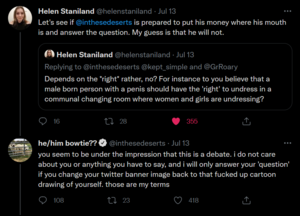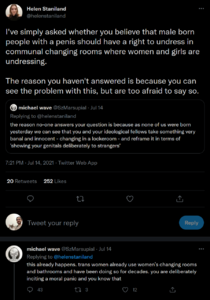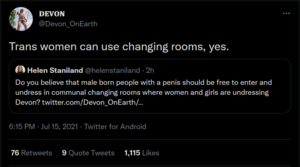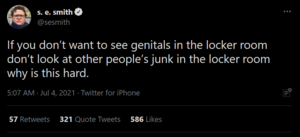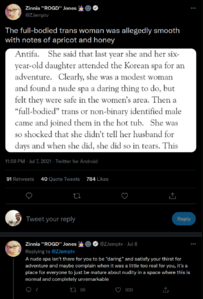Transgender ideology: Difference between revisions
Technician (talk | contribs) No edit summary |
Technician (talk | contribs) More reversals. |
||
| Line 67: | Line 67: | ||
=== Cisgender people oppress transgender people === | === Cisgender people oppress transgender people === | ||
Another core tenet of transgender ideology is the notion that | Another core tenet of transgender ideology is the notion that [[cisgender]] people oppress transgender people, just like how men oppress women, white Americans oppress black Americans, or how straight people oppress gay men and lesbian women.<ref name=cissexism/><ref name=transmisogyny/> As such, when a man identifies as a transwoman, his position relative to that of a woman turns from being her oppressor to someone who is oppressed by her. His male privilege is denied as he is now considered a woman, and the fact that he is a ''transgender'' woman means that he is oppressed by so-called ''cisgender'' women. Further, being both a woman and transgender means he is considered to suffer under two axes of oppression, akin to how black women suffer both from racism and sexism. This way, a white man suddenly becomes comparable to a black woman with regards to oppressive power dynamics in society. | ||
As per the principle of ''intersectionality'' (misappropriated from [[black feminism]]), transgender activists often say that the feminist movement should not only include transwomen's concerns, but outright center them in many discussions, as otherwise the feminist movement might fail to sufficiently address their concerns. (TODO: citation) | |||
=== Supporting "sex work" activism === | === Supporting "sex work" activism === | ||
Revision as of 16:14, 12 October 2022
Transgender ideology is a loose catch-all term referring to philosophies, world views, and dogmatic statements adhered to by political activists who try (or see themselves as trying) to uphold the human rights of transgender people. The political movement of furthering these ideologies is called the transgender movement.
The practice of supporting transgender ideology is called transgender activism (often shortened trans activism) and a person who follows this practice is called a transgender activist (often shortened trans activist). The word "transgender" in the phrase "transgender activist" is not to be understood as an adjective for the person in question (i.e. "an activist who happens to be transgender") but as a reference to the activism they practice (i.e. "an activist supporting transgender ideology"). Many trans activists are not transgender themselves.
Feminists tend to use the term transgender ideology with a critical tone when pointing out sexist, homophobic, or otherwise problematic aspects of the transgender movement. Those who support the movement tend to oppose the term, likening it to the phrase homosexual agenda, which is used to ascribe sinister intent to gay/lesbian/bisexual rights activists. Indeed, right-wing and Christian organizations heavily use the term transgender ideology in their publications critical of the movement, however their reasons for opposing it tend to be radically different than those of feminists.
The term trans rights activist (shortened TRA) is sometimes used for its similarity to men's rights activist (shortened MRA). The idea behind using the term is: just like so-called MRAs claim to support men's human rights but end up blaming everything on women and opposing feminism, so do TRAs claim to support transgender human rights but end up blaming everything on women and opposing feminism.
Aspects
Trans women are women
One of the core dogmata of the transgender movement is the statement that trans women are women (and the less often repeated trans men are men).[1] Under this view, it's important to write trans woman as two words (adjective and noun) and not transwoman, to stress the fact that "trans women" are literally a subtype of women, just like white women, black women, short women, tall women, and so on. The statement "trans women are women" is not meant as a vague slogan of moral support, but in a literal sense.[2][3]
Since the statement contradicts the dictionary definition of the word "woman" (adult human female), it implies that a different definition would be better. When asked about this, transgender activists usually avoid providing an actual definition. Most attempts tend to revolve around a circular definition, such as "anyone who identifies as a woman, is a woman." As such, the statement "trans women are women" is arguably best described as dogma.
The idea that transwomen are literally women is taken as the basis for many problematic conclusions, such as: transwomen deserve to partake in women's sports,[4] transwomen should be seen as part of the natural dating pool of lesbians (see also cotton ceiling),[5] transwomen deserve to use all female facilities, enter female-only spaces and events, speak on women's rights as women, and so on.[3] These issues are made only worse by the fact that any intact male person can simply self-identify as a "trans woman" without needing to undergo any sort of medical transition.
Intact males in women's spaces
If male people who identify as women are literally women, it would follow that they should be allowed to use the same locker rooms, communal showers, and other such sex-segregated public facilities for women. Helen Staniland summarizes this issue by posing the rhetorical question, "should male born people with a penis be free to enter and undress in communal changing rooms where women and girls are undressing?" The question has been dubbed the Staniland Question. Most trans activists refuse to provide a straight answer, as saying no would mean that they don't agree that self-identified "trans women" should be allowed in women's locker rooms, whereas saying yes reveals the very problem being demonstrated.
- Some trans activist men struggling with the Staniland Question
-
Nate avoids giving a straight answer
-
Michael says it's been happening for decades
-
Devon, finally, gives a straight answer
The images above are from discussions in July 2021 that sparked after an incident in Wi Spa, L.A., in which a woman complained about a male person with a penis wandering around naked in the women's section of the nude spa.[6][7][8] Without any actual evidence, trans activist groups cast widespread doubt on the event and managed to get mainstream and local media publications to report that the incident "might have been staged."[7][9][10] It's noteworthy that while some trans activists went the route of claiming that the incident must have been staged, others chose to openly defend the principle of an intact male using female-only spaces (see images above), hence rendering moot the question of whether the incident was or wasn't staged.
After the incident, another woman came forth about the same thing having happened to her in Wi Spa in 2018, and agreed to a detailed interview with journalist Anna Slatz about her experience.[6]
Some trans activists reacting to these stories went as far as saying that women were at fault for looking at the male person, that they are the real sexual aggressors for eyeing the male person in the female-only section, or making jokes about how the women must have been aroused by the man.
- Trans activists going all out with their victim-blaming
-
A person who writes for The Guardian and has a verified Twitter account says women are at fault for looking at the nude male in the women's section
-
Zinnia Jones mocks the second woman who came forth about her experience in 2018
-
A verified account backs the logic put forth by a troll who implies that women are the real aggressors
Males in women's sports
Main article: Transwomen in women's sports
Another logical conclusion of "trans women are women" is that males who identify as women get to play in women's sports. This idea is indeed widely supported by trans activists, and has been applied in many sports events, leading to male athletes at times massively overpowering female competitors and taking the first spot / gold medal. See the above linked page for details on this topic.
Gender identity

The idea that "trans women are women" is sometimes backed by a belief in an essential, inborn, and immutable "gender identity" that every person supposedly possesses.[11][12] Transwomen are said to be real women on the grounds that they possess a "female gender identity" which they are said to share with women. Likewise for transmen and a male gender identity that is supposedly shared by all men. Others believe that all words are social constructs that lack objective definitions. Nevertheless, they argue the terms "man" and "woman" hold a particularly meaningful role with regards to individuals' identities. In the absence of an inherently true definition to protect, they support basing gender in self-identification.
The conclusion to such ideas is that biological sex characteristics do not factor into womanhood and manhood at all. For example, some transwomen have full beards, and most have intact male genitals, yet most trans activists nevertheless claim that such people are literally real women.[13][14]
Transgender children
Since gender identity is said to be inborn, it follows that some children would be transgender, and only need to find this out. Once it's found out, the only way forward is to support the child in its transgender identification. This leads to the transgender activist "affirm-only" approach towards youth, where for instance a boy who says "I wish I was a girl" or "I'm actually a girl" is from that point on treated as if the child is literally a girl. (Given a female name, referred to by female pronouns, asked to be considered a girl by others, and so on.) Likewise for girls who express that they wish they were a boy, or claim that they are internally a boy. Trans activists are opposed to the alternative "watchful waiting" approach.
The trans activist affirm-only approach has been supported by the American Academy of Pediatrics.[15] Parents concerned over this model of treatment published a long criticism and launched a petition reaching 1,200 signatures.[16] Psychologist James Cantor also published a fact-check article criticizing the AAP's decision.[17]
Trans activists usually support giving puberty blocking medication such as Lupron to children who think they are transgender.[15] These children may be as young as 9 years old, and may be prescribed cross-sex hormones at ages as young as 12.[18][19]
According to a 2022 report by Reuters looking at U.S. health insurance claims within the three-year period from the start of 2019 to the end of 2021, there were at least 774 mastectomies, and at least 56 genital surgeries, performed on minors in the age range of 13 to 17.[20] While the data do not reveal the actual youngest age of a patient receiving genital surgery (merely that they are in the age range of 13 to 17), a study published in May 2018 confirms that when it comes to mastectomies, they really are performed on minors as young as 13.[21]
Cisgender people oppress transgender people
Another core tenet of transgender ideology is the notion that cisgender people oppress transgender people, just like how men oppress women, white Americans oppress black Americans, or how straight people oppress gay men and lesbian women.[22][23] As such, when a man identifies as a transwoman, his position relative to that of a woman turns from being her oppressor to someone who is oppressed by her. His male privilege is denied as he is now considered a woman, and the fact that he is a transgender woman means that he is oppressed by so-called cisgender women. Further, being both a woman and transgender means he is considered to suffer under two axes of oppression, akin to how black women suffer both from racism and sexism. This way, a white man suddenly becomes comparable to a black woman with regards to oppressive power dynamics in society.
As per the principle of intersectionality (misappropriated from black feminism), transgender activists often say that the feminist movement should not only include transwomen's concerns, but outright center them in many discussions, as otherwise the feminist movement might fail to sufficiently address their concerns. (TODO: citation)
Supporting "sex work" activism
For reasons not entirely clear, many if not most transgender activists also seem to support the "sex work" movement.[24]
See also
References
- ↑ Alicia Hendley (April 10, 2019). I supported trans ideology until I couldn’t anymore. Feminist Current.
- ↑ Carol Hay (April 1, 2019). Who Counts as a Woman?. The New York Times.
- ↑ 3.0 3.1 The truth about trans. Stonewall UK.
- ↑ Alan Dawson (April 17, 2019). The biggest thing critics continually get wrong about transgender athletes competing in women's sports. Business Insider.
- ↑ Miranda Yardley (December 9, 2018). Girl Dick, the Cotton Ceiling and the Cultural War on Lesbians and Women. Medium.com.
- ↑ 6.0 6.1 Anna Slatz (July 7, 2021). LAPD Officer Blamed a Mother for Exposing her Daughter to Male Genitals at Wi Spa. 4W.
- ↑ 7.0 7.1 Caroline Anders (July 7, 2021). A trans woman reportedly undressed in a spa. Customers said they were ‘traumatized,’ and a protest ensued.. The Washington Post.
- ↑ Bethany Mandel (July 6, 2021). Furor over trans in LA spa proves progressives aren’t really feminists after all. New York Post.
- ↑ Trudy Ring (July 9, 2021). Was Trans Nudity Incident at Los Angeles Spa Staged?. The Advocate.
- ↑ Alleged Trans incident at upscale LA Spa may have been staged. Los Angeles Blade. July 7, 2021.
- ↑ Understanding Gender. Gender Spectrum. "According to the American Academy of Pediatrics, “By age four, most children have a stable sense of their gender identity.” This core aspect of one’s identity comes from within each of us. Gender identity is an inherent aspect of a person’s make-up. Individuals do not choose their gender, nor can they be made to change it."
- ↑ Transsexualism: The Inside Story. Gender Identity Research & Education Society. Archived
- ↑ James Michael Nichols (July 25, 2015). This Incredible Trans Woman Is Challenging The Way We Think About Gender. Huffington Post.
- ↑ Sessi Kuwabara Blanchard (January 29, 2019). The Ins and Outs of Topping as a Trans Girl. Vice.
- ↑ 15.0 15.1 Perri Klass (October 15, 2018). Helping Pediatricians Care for Transgender Children. The New York Times.
- ↑ Parents petition American Academy of Pediatrics in response to policy statement on trans-identified youth. 4thWaveNow. October 29, 2018.
- ↑ James Cantor (October 17, 2018). American Academy of Pediatrics policy and trans- kids: Fact-checking. Sexology Today!.
- ↑ Kate Lyons (July 11, 2016). UK doctor prescribing cross-sex hormones to children as young as 12. The Guardian.
- ↑ Puberty blockers. Transgender Trend.
- ↑ Robin Respaut & Chad Terhune (October 6, 2022). Putting numbers on the rise in children seeking gender care. Reuters.
- ↑ Johanna Olson-Kennedy, MD; Jonathan Warus, MD; Vivian Okonta, MPH; et al (May 2018). Chest Reconstruction and Chest Dysphoria in Transmasculine Minors and Young Adults. JAMA Pediatrics.
- ↑ Cite error: Invalid
<ref>tag; no text was provided for refs namedcissexism - ↑ Cite error: Invalid
<ref>tag; no text was provided for refs namedtransmisogyny - ↑ Julie Bindel (October 2, 2017). The pact between trans rights advocates and the sex trade lobby. Feminist Current.
Cite error: <ref> tag with name "youth-accepted-by-families" defined in <references> is not used in prior text.
Cite error: <ref> tag with name "trans-homelessness" defined in <references> is not used in prior text.
Cite error: <ref> tag with name "ef-cissexism" defined in <references> is not used in prior text.
Cite error: <ref> tag with name "ef-transmisogyny" defined in <references> is not used in prior text.
